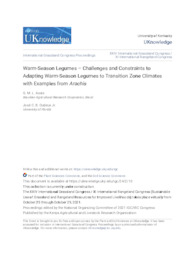Warm-season legumes: challenges and constraints to adapting warm-season legumes to transition zone climates with examples from Arachis.
Warm-season legumes: challenges and constraints to adapting warm-season legumes to transition zone climates with examples from Arachis.
Author(s): ASSIS, G. M. L. de; DUBEUX JUNIOR, J. C. B.
Summary: Grass pastures in monoculture are the predominant system in transition zone climates, where warm-season perennial grasses are usually cultivated. Mixed grass-legume pastures are worldwide recognized for having advantages over pure stands, including pasture longevity, N input from biological fixation, efficient nutrient cycling, and greater animal production. The genus Arachis encompasses important and successful warmseason forage legume species cultivated in mixed pastures or in pure stands. Arachis pintoi and Arachis glabrata are potential tropical forage species that can be used in transition zone climates. Mixed pastures with these legumes have been shown to be resilient systems, able to withstand short-term perturbations, like pests, diseases, drought, or flooding. Wide adoption of A. glabrata is constrained by its high cost and slow establishment period. This species has low potential to produce seeds, and rhizomes are required for propagation. Although great seed production is verified in some A. pintoi genotypes, vegetative propagation is also most often used, since seeds are produced underground, and a large-scale commercial seed production depends on the development of an efficient seed harvester. Developing new cultivars with persistent link between seed and peg is a great challenge for breeders. A. pintoi spreads faster than A. glabrata in tropical regions, and the genetic variability for lateral expansion and ground cover in mixed stands must be better understood in humid subtropical climates. The evaluation of Arachis wild germplasm has already shown genetic variability for traits of interest for use in mixed pastures. Studies have also shown that there is genotype x environment interaction considering tropical and subtropical climates. The greatest chances of success in obtaining more adapted, productive, and faster establishing Arachis cultivarsfor transition zone climates seems to be no longer in the identification of superior wild accessions but in the hybridization and selection through specific breeding programs.
Publication year: 2021
Types of publication: Paper in annals and proceedings
Unit: Embrapa Acre
Keywords: Acclimation, Aclimatación, Aclimatação, Amendoim forrageiro, Arachis glabrata, Arachis pintoi, Cacahuetes forrajeros, Comportamento de Variedade, Crop yield, Ensayos de variedades, Estación cálida, Estação quente, Forage legumes, Forage peanut, Leguminosa Forrageira, Leguminosas forrajeras, Rendimento, Rendimiento de los cultivos, Variety trials, Warm season
Observation
Some of Embrapa's publications are published as ePub files. To read them, use or download one of the following free software options to your computer or mobile device. Android: Google Play Books; IOS: iBooks; Windows and Linux: Calibre.
Access other publications
Access the Agricultural Research Database (BDPA) to consult Embrapa's full library collection and records.
Visit Embrapa Bookstore to purchase books and other publications sold by Embrapa.

